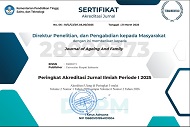Wound Care Management Using Transparent Film Dressing For Reduced Eyelid Edema Skin Elderly
Abstract
Keywords : Transparent film dressing, Reduced edema, Skin elderly
Full Text:
PDFReferences
R.A. Bryant. Acute and Chronic Wound current Management concepts, Fifth Edition, Elsevier, Washington, 2012.
H. N. Chalise. Aging: Basic concept, American journal of biomedical science & research, 2019. DOI: 10.34297/AJBSR.2019.01.000503.
T. Cowan, K. Cutting, K. Fronzo. Wound care handbook 2018-2019 “The compressive guide to product selection”, Journal Wound Care, 2018.
L. P. Guarente, S. Petra, R. Kara. Aging life process, Britannica, 2023.
Mc. Nichole. Wound Management: Wound Ostomy & Continence Nurse Society, Wolters Kluwer, Philadelphia, 2016.
C. A. Miller. Nursing of Wellness in Older Adults, Sixth Edition, Wolters Kluwer, Philadelphia, 2012.
H. K. R. Nair. Study evaluating the efficacy of modified collagen with glycerin in periwound skin management, Kuala Lumpur, 2015.
G. Patel. The Importance of the skin barrier in managing periwound areas, Vol. 2, Wounds International Journal, 2011.
G. Schultz, R. G. Sibbald, V. Fallanga, E. Ayello, C. Dowsett, K. Harding, M. Romanelli, MC. Stacey, L. Teot, W. Vanscheidt. Wound bed preparation: a systematic review approach to wound management, Wound repair regeneration, PubMed, 2003, p. 11S1-28.
G. Schultz, K. Claxton, M. Romanelli. Wound healing and TIME; New concept and scientific applications, Wound healing society, 2005. DOI: https://doi.org/10.1111/j.1067-1927.2005.1304S1.x.
R. Warja. Effectiveness Using of Transparent Film Dressing as Skin Barrier Protection to Prevent Maceration in The Wound Care Process at Bilqiss Medika Clinic Bekasi – West Java, Indonesia, Vol. 6 Issue 8, International Journal of Innovative Science and Research Technology, 2021, p. 647 - 658.
R. J. White, F. K. Cutting. Intervention to avoid maceration of the skin and wound bed, Vol. 12 no. 20, British journal of nursing, 2003, p. 1186 -1201.
G. D. Winter. Formation of the scab and The rate of epithelization of superficial wounds in the skin of the young domestic, Pig Nature, 1962, p.193, p. 293-294.
DOI: https://doi.org/10.52643/joaf.v3i2.4135
Refbacks
- There are currently no refbacks.
Copyright (c) 2024 Journal of Ageing And Family

This work is licensed under a Creative Commons Attribution 4.0 International License.

This work is licensed under a Creative Commons Attribution-ShareAlike 4.0 International License.














